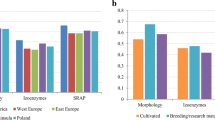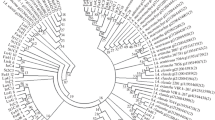Summary
Three weedy amaranths (Amarantkus hybridus, A. retroflexus and A. powellii) from nine California sites, three domesticated species (A. caudatus, A. hypochondriacus and A. cruentus) from the USDA plant inventory as well as other sources and a naturally-occurring crop-weed hybrid were studied for numerical taxonomy using morphological and allozyme variation data. The crop and weedy species groups were easily separated and the hybrid populations were found to be intermediate. Surprisingly, very little intraspecific variation was present. Crop, weed and hybrid amaranths were also compared for their yielding ability, harvest index, seed efficiency of grain production and protein, popping quality and other agronomic traits. Although field plot yields were similar among the three groups of species (700 Kg/ha seed without fertilizer treatment and water, ranging to 3000 Kg/ha with fertilizer applications of 170 Kg N/ha, and abundant water), the harvest index of the weedy group was much higher (25–40%) than the domesticated species (10–15%). The allocation of biomass to seed production is positively correlated with seed yield in the domesticated but not in the weedy types, whereas the percentages of biomass as stem material and as seeds are negatively correlated. Several weedy and crop characteristics together should provide the basis of new improved cultivars through genetic recombination and selection.
Similar content being viewed by others
Literature
Coons, M.P.: The genus Amaranthus in Ecuador. Ph.D. Dissertation. Indiana University (1975)
Downton, W.J.S.: Amaranthus edulis: A high lysine grain amaranth. World Crops 25, 20 (1973)
El-Sharkawy, M.A.: Loomis, R.S.; Williams, W.A.: Photosynthetic and respiratory exchanges of carbon dioxide by leaves of the grain amaranth. J. Appl. Ecol. 5, 243–251 (1968)
Frost, R.A.; and Cavers, P.B.: The ecology of pigweeds (Amaranthus) in Ontario. I. Interspecific and intraspecific variation in seed germination among local populations of A. powellii and A. retroflexus. Canad. J. Bot. 53, 1276–1284 (1975)
Hauptli, H.; and Jain, S.K.: Amaranth and meadowfoam: two new crops? Calif. Agric. 31, 6–7 (1977)
Lexander, K.: Quantities and qualities of leaf protein concentrates from wild species and crop species grown under controlled conditions. Ann. Appl. Biol. 66, 193–216 (1970)
Martin, F.W.; and Roberté, R.M.: Edible leaves of the tropics. Mayaguez, Puerto Rico: Antillian College Press. 1975
Marx, J.: Amaranth: A comeback for the food of the Aztecs. Science 198, 40 (1977)
National Academy of Sciences, Washington, D.C.: Under-exploited tropical plants with promising economic value 188 pp 1975
Pal, M.: Evolution and improvement of cultivated amaranths. I. Breeding system and inflorescence structure. Proc. Indian National Sci. Acad. 38B, 28–37 (1972)
Pal, M.; Khoshoo, T.N.: Grain amaranths. In: Evolutionary studies in world crops: Diversity and change in the Indian subcontinent. (Ed. Hutchinson, J.B.), 129–139. Cambridge Univ. Press 1974
Ruttle, J.: Amaranth — the gentle giant Organic Gard. Farm. 106–110, (1976)
Sauer, J.D.: The grain amaranths and their relatives: a revised taxonomic and geographic survey. Ann. Missouri Bot. Garden. 54, 103–137 (1967)
Sauer, J.D.: Grain amaranths, Amaranthus spp. (Amaranthaceae). In: Evolution of Crop Plants (Ed. Simmonds, N.W.), chapter 2, 4–6. 1976
Scandalios, J.: Isozymes in development and differentiation. Ann. Rev. Plant Physiol. 25, 225–258 (1974)
Singh, H.: Grain amaranths, buckwheat and chenopods. Indian Council of Agric. Res., New Delhi, 46 pp. 1961
Tucker, J.M.; Sauer, J.D.: Aberrant Amaranthus populations of the Sacramento — San Joaquin delta, California. Madroño 14, 252–261 (1958)
Author information
Authors and Affiliations
Additional information
Communicated by J. MacKey
Rights and permissions
About this article
Cite this article
Hauptli, H., Jain, S.K. Biosystematics and agronomic potential of some weedy and cultivated amaranths. Theoret. Appl. Genetics 52, 177–185 (1978). https://doi.org/10.1007/BF00282575
Received:
Issue Date:
DOI: https://doi.org/10.1007/BF00282575




